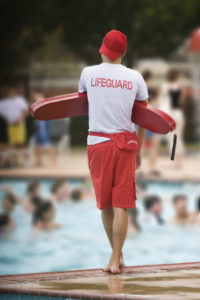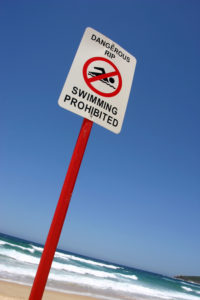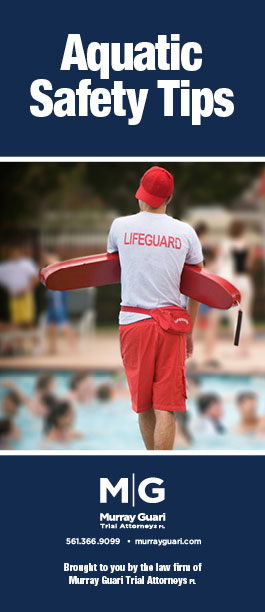
Aquatic Safety Tips
Swimming Pools
Whether a backyard pool, community pool, hotel or cruise ship pool—it’s essential to take precautions to prevent drownings, swimming pool accidents, and slip-and-fall accidents.
Property owners also need to be aware that failing to take an active role in pool safety can lead to premises liability claims by anyone who is injured in your swimming pool or facility.

Here are some tips from the U.S. Consumer Product Safety Commission on how to prevent swimming pool accidents and limit your liability:
- Get a fence between your living areas and the water. Completely enclose the pool area with a climb-resistant fence that has self-closing, self-latching gates—with the latch out of children’s reach. This is the first line of protection against small children from getting near the pool unsupervised.
- Take steps to prevent kids or pets from falling into the pool:
- Install a pool safety net or permanent pool cover and always keep the pool covered when not in use. Be certain any pool cover has the right safety features—kids are tempted to walk on top of pool covers and if the cover collapses, they can be trapped beneath.
- Install an audible splash alarm.
- Never leave toys in the pool—kids may try to reach for them.
- If you have an above-ground pool, remove the ladder during winter.
- Have the right emergency equipment at hand. Always have a rescue-grade floatation device on hand, along with a fully stocked first aid kit. Take your cell phone to the pool with you—seconds may count. Be sure to post emergency phone numbers and the address of your pool.
- Install anti-entrapment drain covers so kids aren’t trapped by drain suction. An even safer option is to add a safety vacuum release system, which shuts off the pump when it detects blockage.
- Make sure you and your kids aren’t swallowing water. The instance of gastrointestinal illnesses linked to pools has been rising dramatically, according to the CDC. Some parasites can live for days in chlorinated water.
- Supervise, supervise, supervise—and learn CPR. Seventy-Seven percent of kids injured by submersion are only missing from view for five minutes or less. Drowning can occur completely silently and take mere minutes. Don’t assume kids are safe even if they know how to swim or are using floatation devices.
Beach Safety

Statistics indicate that it is safer to swim on beaches with lifeguard services. Lifeguards are trained not only in injury prevention, but also in emergency response. Should anything go wrong at the beach, a lifeguard can help make the difference between life and death. Areas without lifeguard protection may also be areas that have hidden dangers such as sudden drop-offs, currents and weeds—all which can endanger your safety.
Beach Safety Tips:
- Whenever possible, swim at a lifeguard-protected beach.
- Never swim alone.
- Learn how to swim in the surf. It’s not the same as swimming in a pool or lake.
- Obey all instructions and orders from lifeguards. Lifeguards are trained to identify potential hazards. Ask a lifeguard about the conditions before entering the water.
- Stay at least 100 feet away from piers and jetties. Permanent rip currents often exist alongside these structures.
- Pay especially close attention to children and elderly when at the beach. Even in shallow water, wave action can cause loss of footing and lead to drowning.
Rip Currents

Rip currents are powerful, channeled currents of water flowing away from shore. They typically extend from the shoreline, through the surf zone, and past the line of breaking waves. Rip currents can occur at any beach with breaking waves, including the Great Lakes; and they can be deadly.
The greatest safety precaution you can take is to recognize the danger of rip currents and stay away! Always remember to swim at beaches with lifeguards. If caught in a rip current, how you respond could make the difference between life and death.
If Caught in a Rip Current:
- Remain calm to conserve energy and think clearly.
- Never fight against the current.
- Swim out of the current in a direction following the shoreline. When out of the current, swim at an angle – away from the current – towards shore.
- If you are unable to swim out of the rip current, float or calmly tread water, and when out of the current, swim towards shore.
- If you are still unable to reach shore, draw attention to yourself by waving your arm and yelling for help.












